Environmental Management and Sustainability Report for Ghana Oil
VerifiedAdded on 2022/08/29
|10
|3008
|19
Report
AI Summary
This report focuses on environmental management for sustainable development, specifically for the Ghana Oil Company. It details the design of an integrated management system, considering existing ISO 14001 (environmental management) and ISO 9001 (quality management) standards. The report highlights the similarities and differences between these standards, emphasizing their roles in achieving environmental objectives and ensuring quality. It addresses key barriers to sustainability within an organizational context, such as cultural change, changing environmental perceptions, and lack of clarity, while also outlining management responsibilities in overcoming these challenges through monitoring, evaluation, and resource allocation. The report emphasizes the importance of continual improvement, the PDCA cycle, and the integration of environmental and quality management for enhancing operational efficiency and reducing environmental impact within the company.
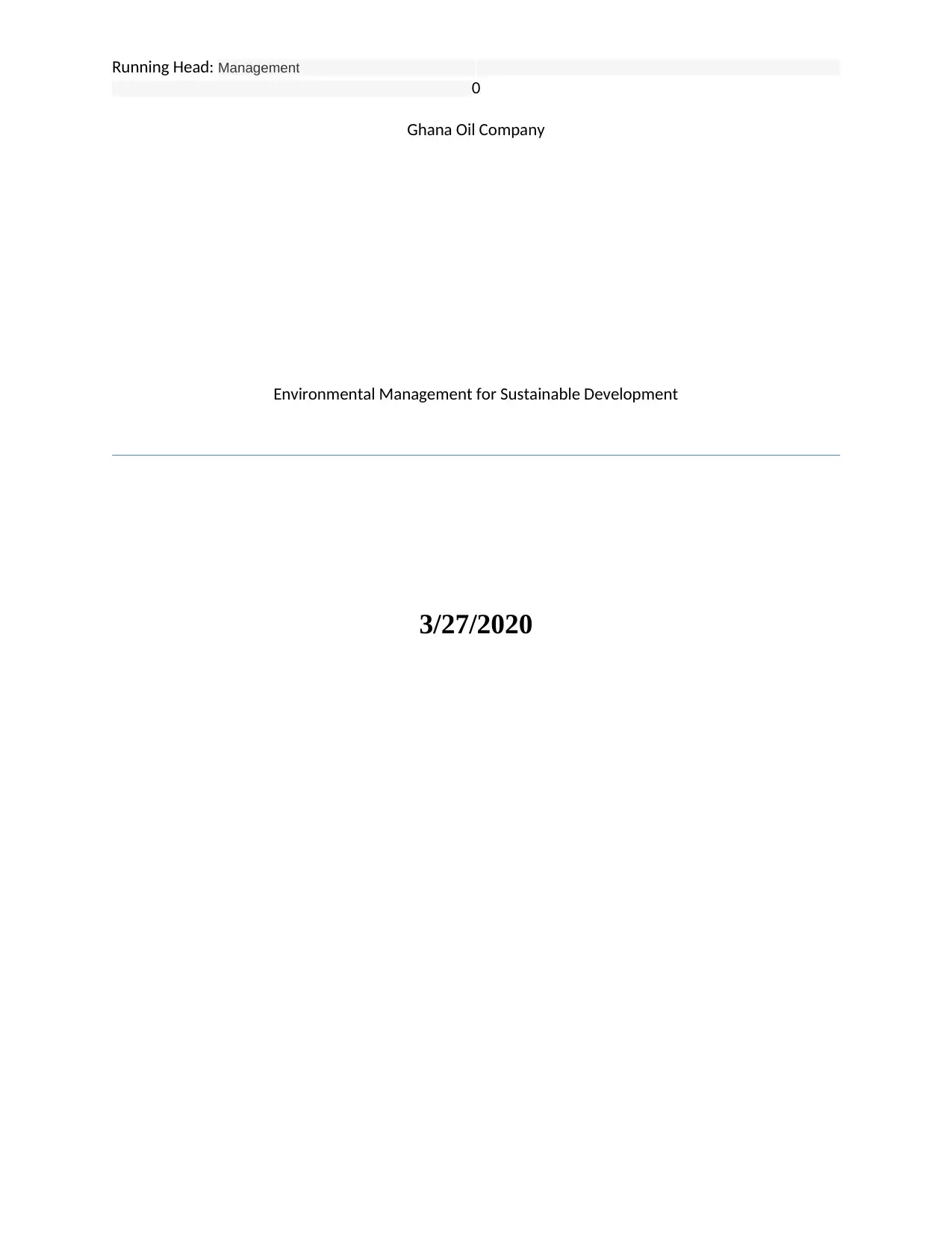
Running Head: Management
0
Ghana Oil Company
Environmental Management for Sustainable Development
3/27/2020
0
Ghana Oil Company
Environmental Management for Sustainable Development
3/27/2020
Paraphrase This Document
Need a fresh take? Get an instant paraphrase of this document with our AI Paraphraser
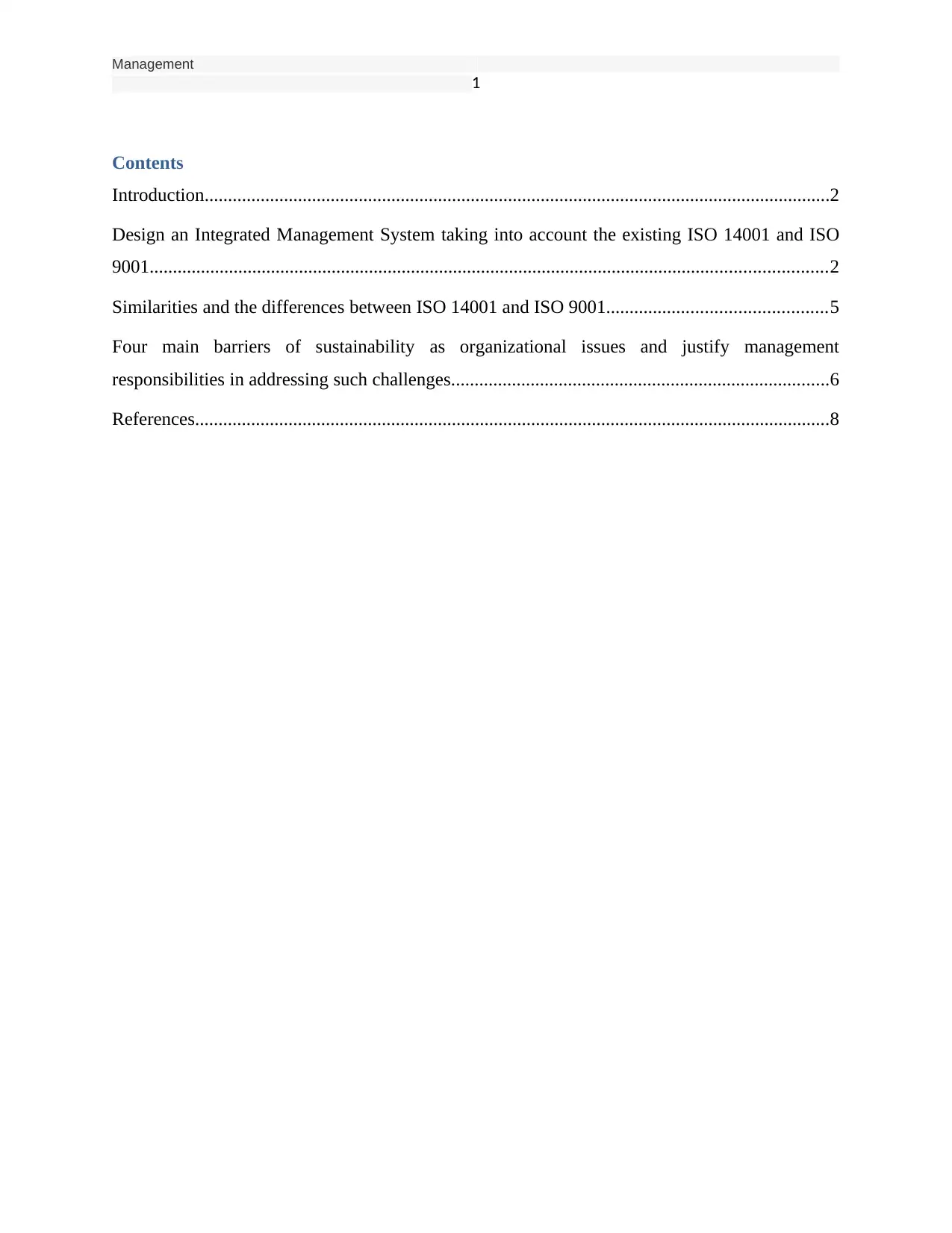
Management
1
Contents
Introduction......................................................................................................................................2
Design an Integrated Management System taking into account the existing ISO 14001 and ISO
9001.................................................................................................................................................2
Similarities and the differences between ISO 14001 and ISO 9001...............................................5
Four main barriers of sustainability as organizational issues and justify management
responsibilities in addressing such challenges.................................................................................6
References........................................................................................................................................8
1
Contents
Introduction......................................................................................................................................2
Design an Integrated Management System taking into account the existing ISO 14001 and ISO
9001.................................................................................................................................................2
Similarities and the differences between ISO 14001 and ISO 9001...............................................5
Four main barriers of sustainability as organizational issues and justify management
responsibilities in addressing such challenges.................................................................................6
References........................................................................................................................................8
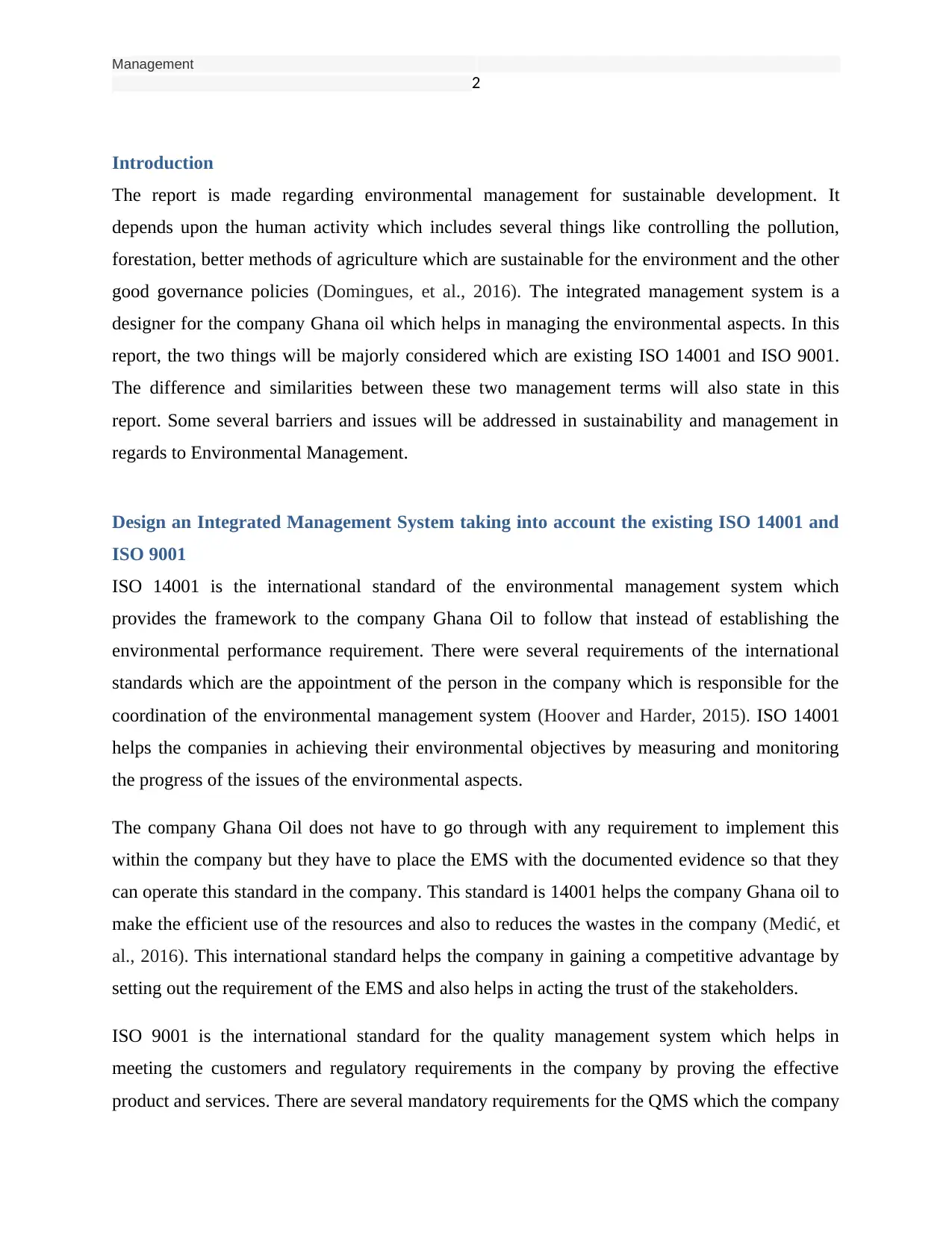
Management
2
Introduction
The report is made regarding environmental management for sustainable development. It
depends upon the human activity which includes several things like controlling the pollution,
forestation, better methods of agriculture which are sustainable for the environment and the other
good governance policies (Domingues, et al., 2016). The integrated management system is a
designer for the company Ghana oil which helps in managing the environmental aspects. In this
report, the two things will be majorly considered which are existing ISO 14001 and ISO 9001.
The difference and similarities between these two management terms will also state in this
report. Some several barriers and issues will be addressed in sustainability and management in
regards to Environmental Management.
Design an Integrated Management System taking into account the existing ISO 14001 and
ISO 9001
ISO 14001 is the international standard of the environmental management system which
provides the framework to the company Ghana Oil to follow that instead of establishing the
environmental performance requirement. There were several requirements of the international
standards which are the appointment of the person in the company which is responsible for the
coordination of the environmental management system (Hoover and Harder, 2015). ISO 14001
helps the companies in achieving their environmental objectives by measuring and monitoring
the progress of the issues of the environmental aspects.
The company Ghana Oil does not have to go through with any requirement to implement this
within the company but they have to place the EMS with the documented evidence so that they
can operate this standard in the company. This standard is 14001 helps the company Ghana oil to
make the efficient use of the resources and also to reduces the wastes in the company (Medić, et
al., 2016). This international standard helps the company in gaining a competitive advantage by
setting out the requirement of the EMS and also helps in acting the trust of the stakeholders.
ISO 9001 is the international standard for the quality management system which helps in
meeting the customers and regulatory requirements in the company by proving the effective
product and services. There are several mandatory requirements for the QMS which the company
2
Introduction
The report is made regarding environmental management for sustainable development. It
depends upon the human activity which includes several things like controlling the pollution,
forestation, better methods of agriculture which are sustainable for the environment and the other
good governance policies (Domingues, et al., 2016). The integrated management system is a
designer for the company Ghana oil which helps in managing the environmental aspects. In this
report, the two things will be majorly considered which are existing ISO 14001 and ISO 9001.
The difference and similarities between these two management terms will also state in this
report. Some several barriers and issues will be addressed in sustainability and management in
regards to Environmental Management.
Design an Integrated Management System taking into account the existing ISO 14001 and
ISO 9001
ISO 14001 is the international standard of the environmental management system which
provides the framework to the company Ghana Oil to follow that instead of establishing the
environmental performance requirement. There were several requirements of the international
standards which are the appointment of the person in the company which is responsible for the
coordination of the environmental management system (Hoover and Harder, 2015). ISO 14001
helps the companies in achieving their environmental objectives by measuring and monitoring
the progress of the issues of the environmental aspects.
The company Ghana Oil does not have to go through with any requirement to implement this
within the company but they have to place the EMS with the documented evidence so that they
can operate this standard in the company. This standard is 14001 helps the company Ghana oil to
make the efficient use of the resources and also to reduces the wastes in the company (Medić, et
al., 2016). This international standard helps the company in gaining a competitive advantage by
setting out the requirement of the EMS and also helps in acting the trust of the stakeholders.
ISO 9001 is the international standard for the quality management system which helps in
meeting the customers and regulatory requirements in the company by proving the effective
product and services. There are several mandatory requirements for the QMS which the company
⊘ This is a preview!⊘
Do you want full access?
Subscribe today to unlock all pages.

Trusted by 1+ million students worldwide
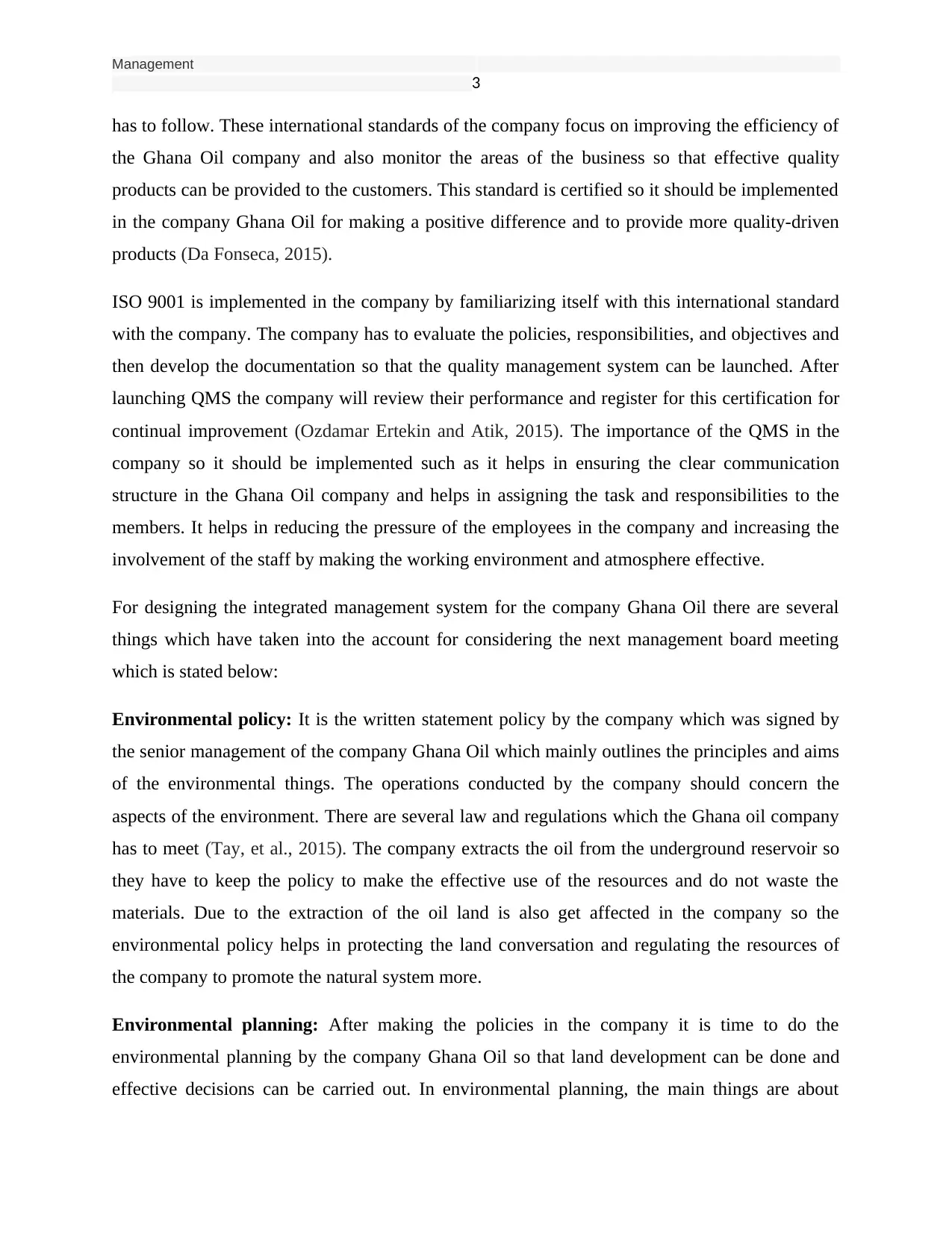
Management
3
has to follow. These international standards of the company focus on improving the efficiency of
the Ghana Oil company and also monitor the areas of the business so that effective quality
products can be provided to the customers. This standard is certified so it should be implemented
in the company Ghana Oil for making a positive difference and to provide more quality-driven
products (Da Fonseca, 2015).
ISO 9001 is implemented in the company by familiarizing itself with this international standard
with the company. The company has to evaluate the policies, responsibilities, and objectives and
then develop the documentation so that the quality management system can be launched. After
launching QMS the company will review their performance and register for this certification for
continual improvement (Ozdamar Ertekin and Atik, 2015). The importance of the QMS in the
company so it should be implemented such as it helps in ensuring the clear communication
structure in the Ghana Oil company and helps in assigning the task and responsibilities to the
members. It helps in reducing the pressure of the employees in the company and increasing the
involvement of the staff by making the working environment and atmosphere effective.
For designing the integrated management system for the company Ghana Oil there are several
things which have taken into the account for considering the next management board meeting
which is stated below:
Environmental policy: It is the written statement policy by the company which was signed by
the senior management of the company Ghana Oil which mainly outlines the principles and aims
of the environmental things. The operations conducted by the company should concern the
aspects of the environment. There are several law and regulations which the Ghana oil company
has to meet (Tay, et al., 2015). The company extracts the oil from the underground reservoir so
they have to keep the policy to make the effective use of the resources and do not waste the
materials. Due to the extraction of the oil land is also get affected in the company so the
environmental policy helps in protecting the land conversation and regulating the resources of
the company to promote the natural system more.
Environmental planning: After making the policies in the company it is time to do the
environmental planning by the company Ghana Oil so that land development can be done and
effective decisions can be carried out. In environmental planning, the main things are about
3
has to follow. These international standards of the company focus on improving the efficiency of
the Ghana Oil company and also monitor the areas of the business so that effective quality
products can be provided to the customers. This standard is certified so it should be implemented
in the company Ghana Oil for making a positive difference and to provide more quality-driven
products (Da Fonseca, 2015).
ISO 9001 is implemented in the company by familiarizing itself with this international standard
with the company. The company has to evaluate the policies, responsibilities, and objectives and
then develop the documentation so that the quality management system can be launched. After
launching QMS the company will review their performance and register for this certification for
continual improvement (Ozdamar Ertekin and Atik, 2015). The importance of the QMS in the
company so it should be implemented such as it helps in ensuring the clear communication
structure in the Ghana Oil company and helps in assigning the task and responsibilities to the
members. It helps in reducing the pressure of the employees in the company and increasing the
involvement of the staff by making the working environment and atmosphere effective.
For designing the integrated management system for the company Ghana Oil there are several
things which have taken into the account for considering the next management board meeting
which is stated below:
Environmental policy: It is the written statement policy by the company which was signed by
the senior management of the company Ghana Oil which mainly outlines the principles and aims
of the environmental things. The operations conducted by the company should concern the
aspects of the environment. There are several law and regulations which the Ghana oil company
has to meet (Tay, et al., 2015). The company extracts the oil from the underground reservoir so
they have to keep the policy to make the effective use of the resources and do not waste the
materials. Due to the extraction of the oil land is also get affected in the company so the
environmental policy helps in protecting the land conversation and regulating the resources of
the company to promote the natural system more.
Environmental planning: After making the policies in the company it is time to do the
environmental planning by the company Ghana Oil so that land development can be done and
effective decisions can be carried out. In environmental planning, the main things are about
Paraphrase This Document
Need a fresh take? Get an instant paraphrase of this document with our AI Paraphraser
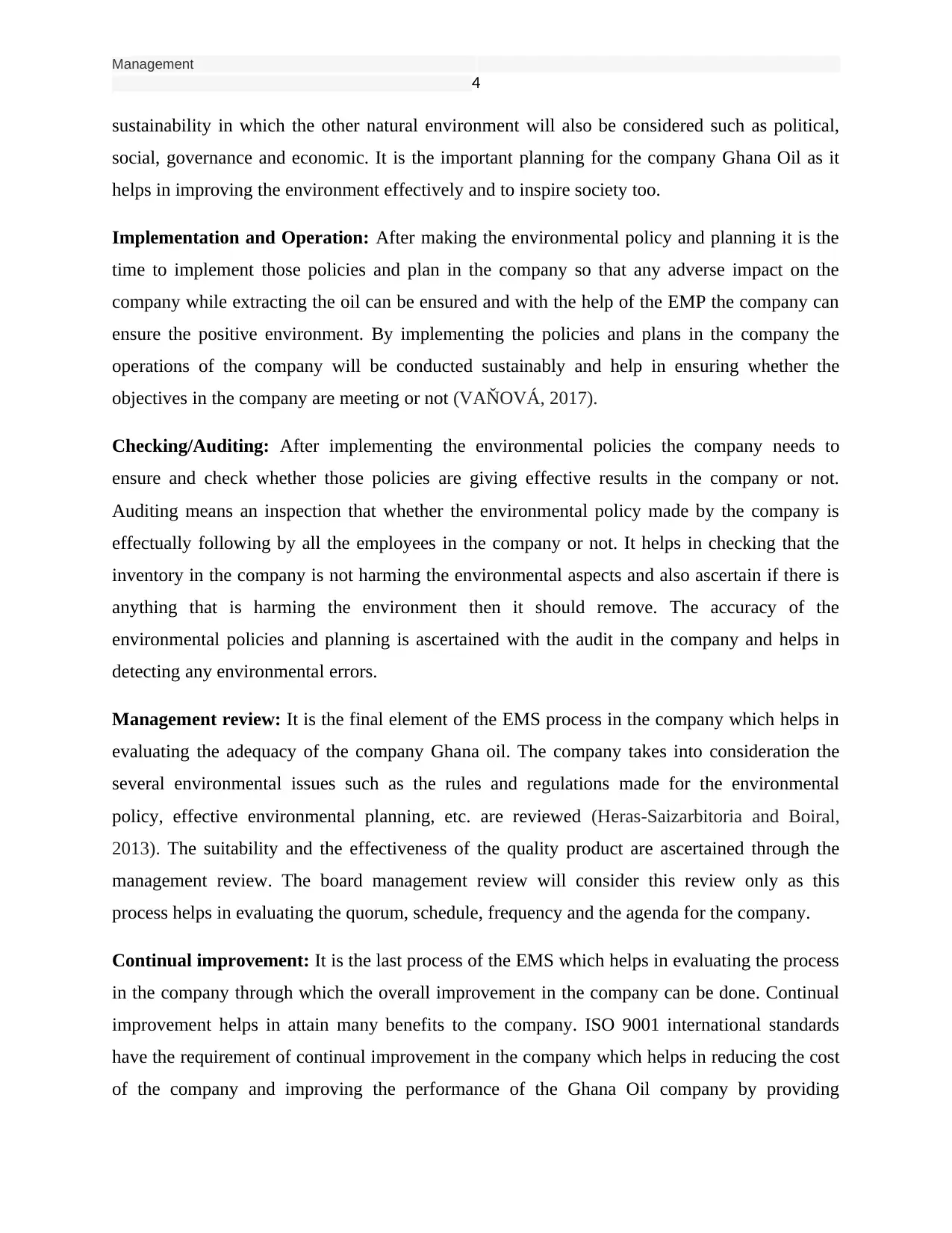
Management
4
sustainability in which the other natural environment will also be considered such as political,
social, governance and economic. It is the important planning for the company Ghana Oil as it
helps in improving the environment effectively and to inspire society too.
Implementation and Operation: After making the environmental policy and planning it is the
time to implement those policies and plan in the company so that any adverse impact on the
company while extracting the oil can be ensured and with the help of the EMP the company can
ensure the positive environment. By implementing the policies and plans in the company the
operations of the company will be conducted sustainably and help in ensuring whether the
objectives in the company are meeting or not (VAŇOVÁ, 2017).
Checking/Auditing: After implementing the environmental policies the company needs to
ensure and check whether those policies are giving effective results in the company or not.
Auditing means an inspection that whether the environmental policy made by the company is
effectually following by all the employees in the company or not. It helps in checking that the
inventory in the company is not harming the environmental aspects and also ascertain if there is
anything that is harming the environment then it should remove. The accuracy of the
environmental policies and planning is ascertained with the audit in the company and helps in
detecting any environmental errors.
Management review: It is the final element of the EMS process in the company which helps in
evaluating the adequacy of the company Ghana oil. The company takes into consideration the
several environmental issues such as the rules and regulations made for the environmental
policy, effective environmental planning, etc. are reviewed (Heras‐Saizarbitoria and Boiral,
2013). The suitability and the effectiveness of the quality product are ascertained through the
management review. The board management review will consider this review only as this
process helps in evaluating the quorum, schedule, frequency and the agenda for the company.
Continual improvement: It is the last process of the EMS which helps in evaluating the process
in the company through which the overall improvement in the company can be done. Continual
improvement helps in attain many benefits to the company. ISO 9001 international standards
have the requirement of continual improvement in the company which helps in reducing the cost
of the company and improving the performance of the Ghana Oil company by providing
4
sustainability in which the other natural environment will also be considered such as political,
social, governance and economic. It is the important planning for the company Ghana Oil as it
helps in improving the environment effectively and to inspire society too.
Implementation and Operation: After making the environmental policy and planning it is the
time to implement those policies and plan in the company so that any adverse impact on the
company while extracting the oil can be ensured and with the help of the EMP the company can
ensure the positive environment. By implementing the policies and plans in the company the
operations of the company will be conducted sustainably and help in ensuring whether the
objectives in the company are meeting or not (VAŇOVÁ, 2017).
Checking/Auditing: After implementing the environmental policies the company needs to
ensure and check whether those policies are giving effective results in the company or not.
Auditing means an inspection that whether the environmental policy made by the company is
effectually following by all the employees in the company or not. It helps in checking that the
inventory in the company is not harming the environmental aspects and also ascertain if there is
anything that is harming the environment then it should remove. The accuracy of the
environmental policies and planning is ascertained with the audit in the company and helps in
detecting any environmental errors.
Management review: It is the final element of the EMS process in the company which helps in
evaluating the adequacy of the company Ghana oil. The company takes into consideration the
several environmental issues such as the rules and regulations made for the environmental
policy, effective environmental planning, etc. are reviewed (Heras‐Saizarbitoria and Boiral,
2013). The suitability and the effectiveness of the quality product are ascertained through the
management review. The board management review will consider this review only as this
process helps in evaluating the quorum, schedule, frequency and the agenda for the company.
Continual improvement: It is the last process of the EMS which helps in evaluating the process
in the company through which the overall improvement in the company can be done. Continual
improvement helps in attain many benefits to the company. ISO 9001 international standards
have the requirement of continual improvement in the company which helps in reducing the cost
of the company and improving the performance of the Ghana Oil company by providing
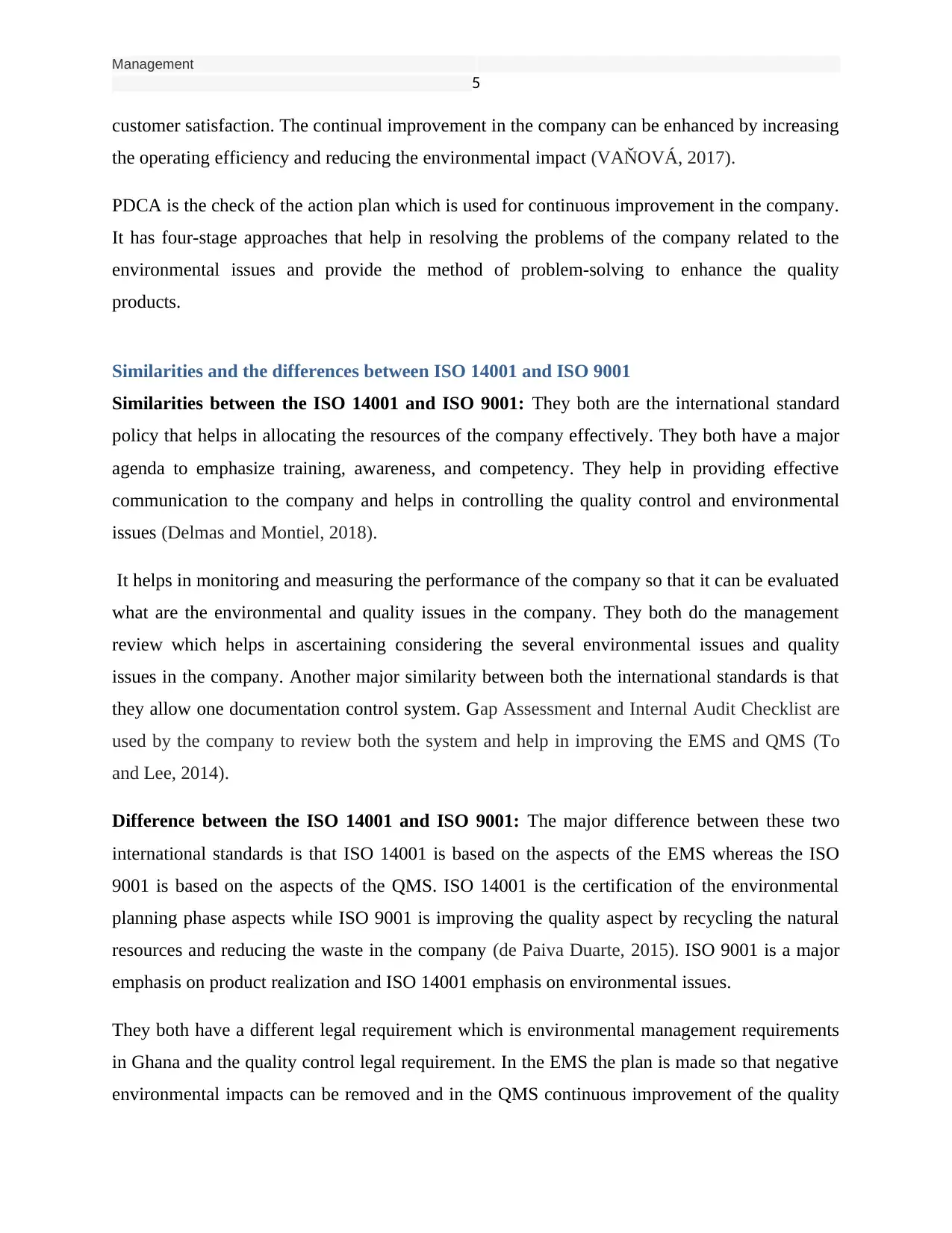
Management
5
customer satisfaction. The continual improvement in the company can be enhanced by increasing
the operating efficiency and reducing the environmental impact (VAŇOVÁ, 2017).
PDCA is the check of the action plan which is used for continuous improvement in the company.
It has four-stage approaches that help in resolving the problems of the company related to the
environmental issues and provide the method of problem-solving to enhance the quality
products.
Similarities and the differences between ISO 14001 and ISO 9001
Similarities between the ISO 14001 and ISO 9001: They both are the international standard
policy that helps in allocating the resources of the company effectively. They both have a major
agenda to emphasize training, awareness, and competency. They help in providing effective
communication to the company and helps in controlling the quality control and environmental
issues (Delmas and Montiel, 2018).
It helps in monitoring and measuring the performance of the company so that it can be evaluated
what are the environmental and quality issues in the company. They both do the management
review which helps in ascertaining considering the several environmental issues and quality
issues in the company. Another major similarity between both the international standards is that
they allow one documentation control system. Gap Assessment and Internal Audit Checklist are
used by the company to review both the system and help in improving the EMS and QMS (To
and Lee, 2014).
Difference between the ISO 14001 and ISO 9001: The major difference between these two
international standards is that ISO 14001 is based on the aspects of the EMS whereas the ISO
9001 is based on the aspects of the QMS. ISO 14001 is the certification of the environmental
planning phase aspects while ISO 9001 is improving the quality aspect by recycling the natural
resources and reducing the waste in the company (de Paiva Duarte, 2015). ISO 9001 is a major
emphasis on product realization and ISO 14001 emphasis on environmental issues.
They both have a different legal requirement which is environmental management requirements
in Ghana and the quality control legal requirement. In the EMS the plan is made so that negative
environmental impacts can be removed and in the QMS continuous improvement of the quality
5
customer satisfaction. The continual improvement in the company can be enhanced by increasing
the operating efficiency and reducing the environmental impact (VAŇOVÁ, 2017).
PDCA is the check of the action plan which is used for continuous improvement in the company.
It has four-stage approaches that help in resolving the problems of the company related to the
environmental issues and provide the method of problem-solving to enhance the quality
products.
Similarities and the differences between ISO 14001 and ISO 9001
Similarities between the ISO 14001 and ISO 9001: They both are the international standard
policy that helps in allocating the resources of the company effectively. They both have a major
agenda to emphasize training, awareness, and competency. They help in providing effective
communication to the company and helps in controlling the quality control and environmental
issues (Delmas and Montiel, 2018).
It helps in monitoring and measuring the performance of the company so that it can be evaluated
what are the environmental and quality issues in the company. They both do the management
review which helps in ascertaining considering the several environmental issues and quality
issues in the company. Another major similarity between both the international standards is that
they allow one documentation control system. Gap Assessment and Internal Audit Checklist are
used by the company to review both the system and help in improving the EMS and QMS (To
and Lee, 2014).
Difference between the ISO 14001 and ISO 9001: The major difference between these two
international standards is that ISO 14001 is based on the aspects of the EMS whereas the ISO
9001 is based on the aspects of the QMS. ISO 14001 is the certification of the environmental
planning phase aspects while ISO 9001 is improving the quality aspect by recycling the natural
resources and reducing the waste in the company (de Paiva Duarte, 2015). ISO 9001 is a major
emphasis on product realization and ISO 14001 emphasis on environmental issues.
They both have a different legal requirement which is environmental management requirements
in Ghana and the quality control legal requirement. In the EMS the plan is made so that negative
environmental impacts can be removed and in the QMS continuous improvement of the quality
⊘ This is a preview!⊘
Do you want full access?
Subscribe today to unlock all pages.

Trusted by 1+ million students worldwide
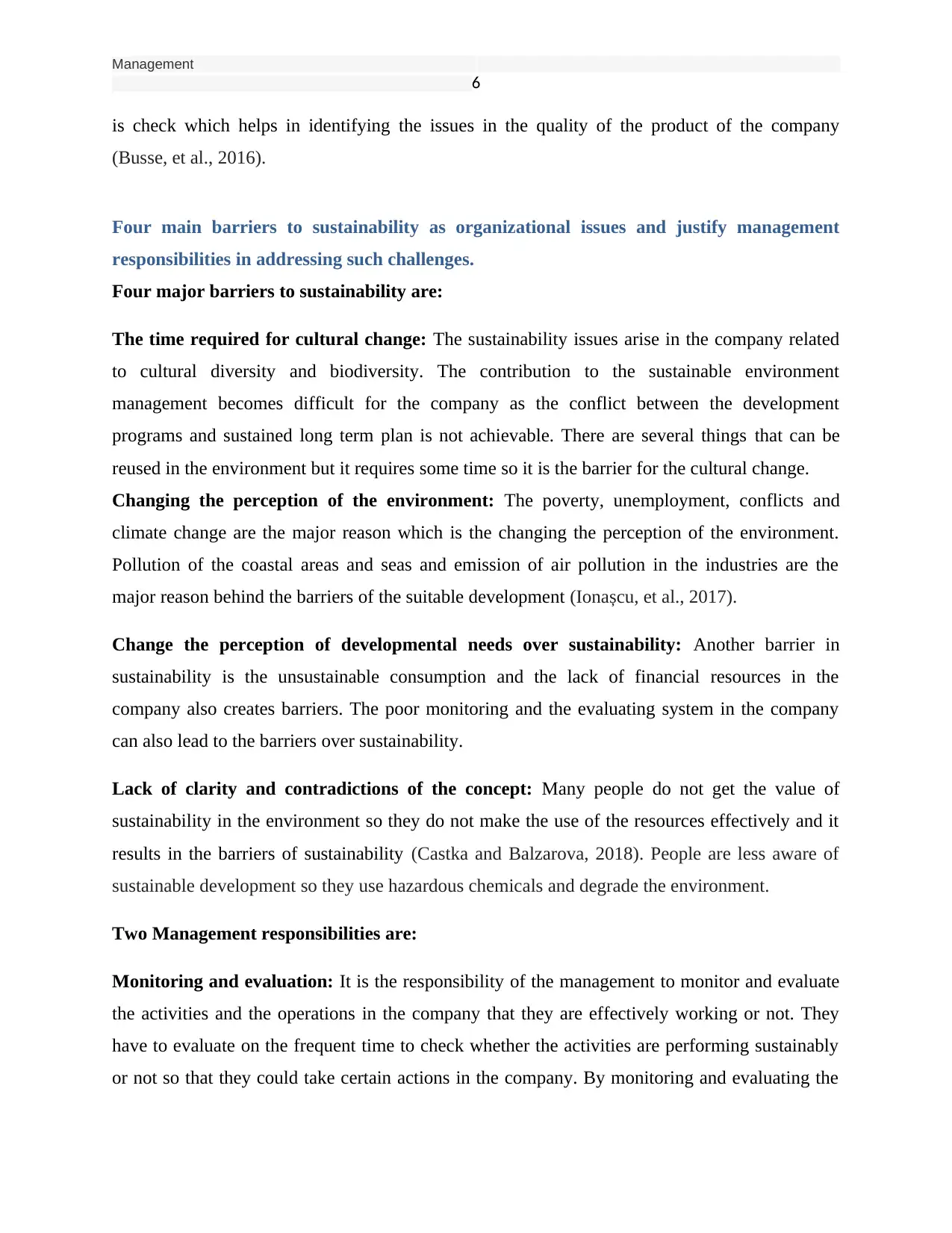
Management
6
is check which helps in identifying the issues in the quality of the product of the company
(Busse, et al., 2016).
Four main barriers to sustainability as organizational issues and justify management
responsibilities in addressing such challenges.
Four major barriers to sustainability are:
The time required for cultural change: The sustainability issues arise in the company related
to cultural diversity and biodiversity. The contribution to the sustainable environment
management becomes difficult for the company as the conflict between the development
programs and sustained long term plan is not achievable. There are several things that can be
reused in the environment but it requires some time so it is the barrier for the cultural change.
Changing the perception of the environment: The poverty, unemployment, conflicts and
climate change are the major reason which is the changing the perception of the environment.
Pollution of the coastal areas and seas and emission of air pollution in the industries are the
major reason behind the barriers of the suitable development (Ionașcu, et al., 2017).
Change the perception of developmental needs over sustainability: Another barrier in
sustainability is the unsustainable consumption and the lack of financial resources in the
company also creates barriers. The poor monitoring and the evaluating system in the company
can also lead to the barriers over sustainability.
Lack of clarity and contradictions of the concept: Many people do not get the value of
sustainability in the environment so they do not make the use of the resources effectively and it
results in the barriers of sustainability (Castka and Balzarova, 2018). People are less aware of
sustainable development so they use hazardous chemicals and degrade the environment.
Two Management responsibilities are:
Monitoring and evaluation: It is the responsibility of the management to monitor and evaluate
the activities and the operations in the company that they are effectively working or not. They
have to evaluate on the frequent time to check whether the activities are performing sustainably
or not so that they could take certain actions in the company. By monitoring and evaluating the
6
is check which helps in identifying the issues in the quality of the product of the company
(Busse, et al., 2016).
Four main barriers to sustainability as organizational issues and justify management
responsibilities in addressing such challenges.
Four major barriers to sustainability are:
The time required for cultural change: The sustainability issues arise in the company related
to cultural diversity and biodiversity. The contribution to the sustainable environment
management becomes difficult for the company as the conflict between the development
programs and sustained long term plan is not achievable. There are several things that can be
reused in the environment but it requires some time so it is the barrier for the cultural change.
Changing the perception of the environment: The poverty, unemployment, conflicts and
climate change are the major reason which is the changing the perception of the environment.
Pollution of the coastal areas and seas and emission of air pollution in the industries are the
major reason behind the barriers of the suitable development (Ionașcu, et al., 2017).
Change the perception of developmental needs over sustainability: Another barrier in
sustainability is the unsustainable consumption and the lack of financial resources in the
company also creates barriers. The poor monitoring and the evaluating system in the company
can also lead to the barriers over sustainability.
Lack of clarity and contradictions of the concept: Many people do not get the value of
sustainability in the environment so they do not make the use of the resources effectively and it
results in the barriers of sustainability (Castka and Balzarova, 2018). People are less aware of
sustainable development so they use hazardous chemicals and degrade the environment.
Two Management responsibilities are:
Monitoring and evaluation: It is the responsibility of the management to monitor and evaluate
the activities and the operations in the company that they are effectively working or not. They
have to evaluate on the frequent time to check whether the activities are performing sustainably
or not so that they could take certain actions in the company. By monitoring and evaluating the
Paraphrase This Document
Need a fresh take? Get an instant paraphrase of this document with our AI Paraphraser
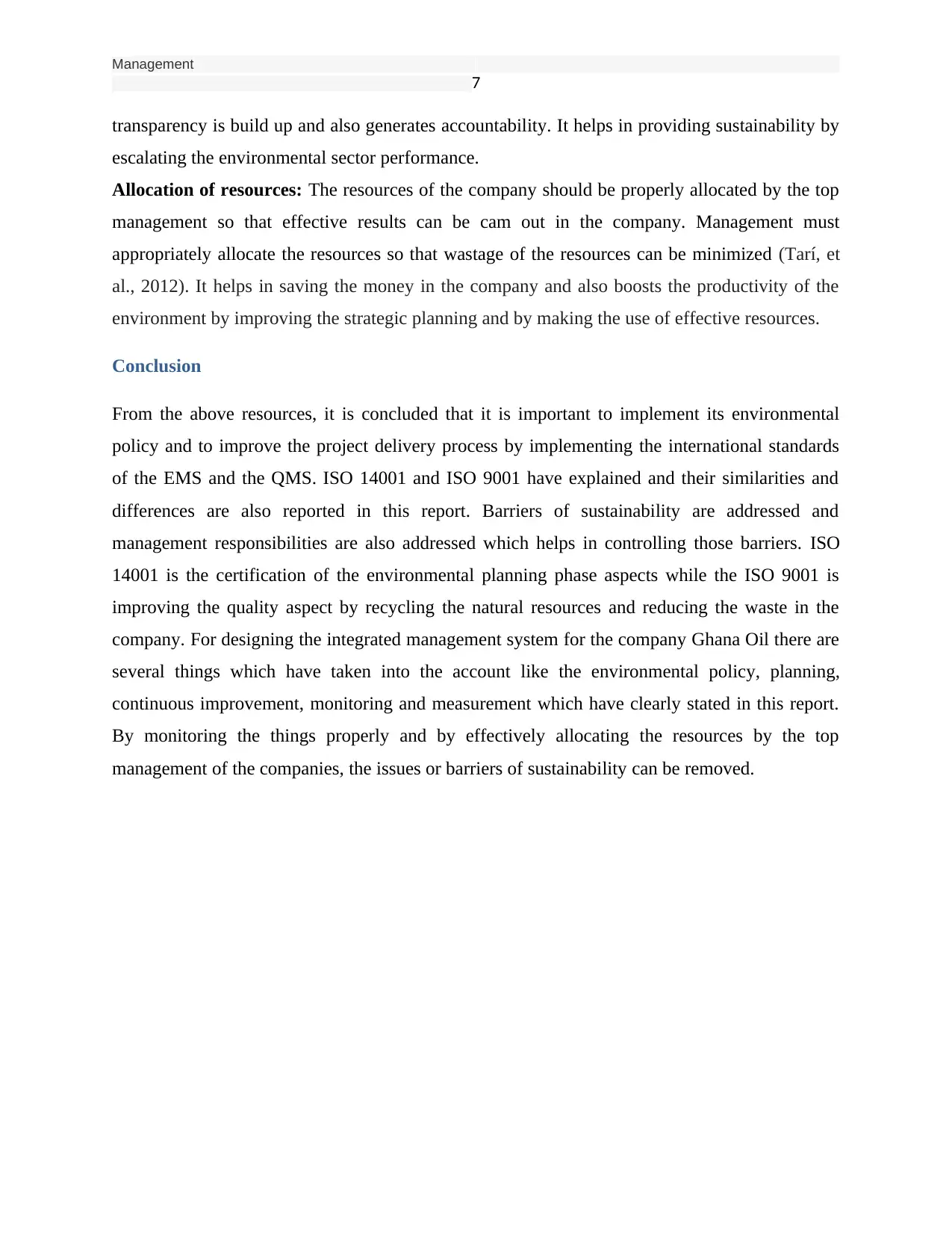
Management
7
transparency is build up and also generates accountability. It helps in providing sustainability by
escalating the environmental sector performance.
Allocation of resources: The resources of the company should be properly allocated by the top
management so that effective results can be cam out in the company. Management must
appropriately allocate the resources so that wastage of the resources can be minimized (Tarí, et
al., 2012). It helps in saving the money in the company and also boosts the productivity of the
environment by improving the strategic planning and by making the use of effective resources.
Conclusion
From the above resources, it is concluded that it is important to implement its environmental
policy and to improve the project delivery process by implementing the international standards
of the EMS and the QMS. ISO 14001 and ISO 9001 have explained and their similarities and
differences are also reported in this report. Barriers of sustainability are addressed and
management responsibilities are also addressed which helps in controlling those barriers. ISO
14001 is the certification of the environmental planning phase aspects while the ISO 9001 is
improving the quality aspect by recycling the natural resources and reducing the waste in the
company. For designing the integrated management system for the company Ghana Oil there are
several things which have taken into the account like the environmental policy, planning,
continuous improvement, monitoring and measurement which have clearly stated in this report.
By monitoring the things properly and by effectively allocating the resources by the top
management of the companies, the issues or barriers of sustainability can be removed.
7
transparency is build up and also generates accountability. It helps in providing sustainability by
escalating the environmental sector performance.
Allocation of resources: The resources of the company should be properly allocated by the top
management so that effective results can be cam out in the company. Management must
appropriately allocate the resources so that wastage of the resources can be minimized (Tarí, et
al., 2012). It helps in saving the money in the company and also boosts the productivity of the
environment by improving the strategic planning and by making the use of effective resources.
Conclusion
From the above resources, it is concluded that it is important to implement its environmental
policy and to improve the project delivery process by implementing the international standards
of the EMS and the QMS. ISO 14001 and ISO 9001 have explained and their similarities and
differences are also reported in this report. Barriers of sustainability are addressed and
management responsibilities are also addressed which helps in controlling those barriers. ISO
14001 is the certification of the environmental planning phase aspects while the ISO 9001 is
improving the quality aspect by recycling the natural resources and reducing the waste in the
company. For designing the integrated management system for the company Ghana Oil there are
several things which have taken into the account like the environmental policy, planning,
continuous improvement, monitoring and measurement which have clearly stated in this report.
By monitoring the things properly and by effectively allocating the resources by the top
management of the companies, the issues or barriers of sustainability can be removed.
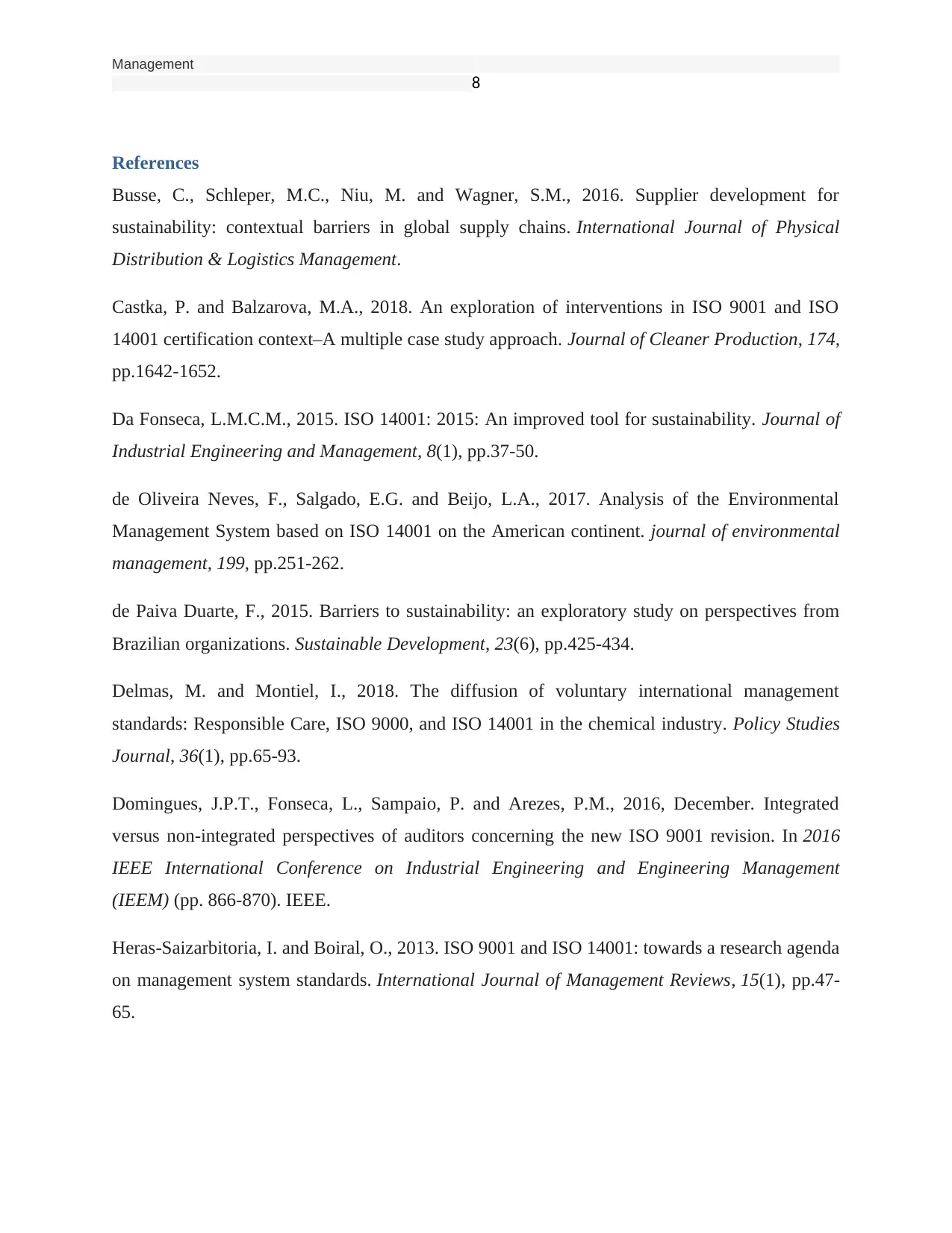
Management
8
References
Busse, C., Schleper, M.C., Niu, M. and Wagner, S.M., 2016. Supplier development for
sustainability: contextual barriers in global supply chains. International Journal of Physical
Distribution & Logistics Management.
Castka, P. and Balzarova, M.A., 2018. An exploration of interventions in ISO 9001 and ISO
14001 certification context–A multiple case study approach. Journal of Cleaner Production, 174,
pp.1642-1652.
Da Fonseca, L.M.C.M., 2015. ISO 14001: 2015: An improved tool for sustainability. Journal of
Industrial Engineering and Management, 8(1), pp.37-50.
de Oliveira Neves, F., Salgado, E.G. and Beijo, L.A., 2017. Analysis of the Environmental
Management System based on ISO 14001 on the American continent. journal of environmental
management, 199, pp.251-262.
de Paiva Duarte, F., 2015. Barriers to sustainability: an exploratory study on perspectives from
Brazilian organizations. Sustainable Development, 23(6), pp.425-434.
Delmas, M. and Montiel, I., 2018. The diffusion of voluntary international management
standards: Responsible Care, ISO 9000, and ISO 14001 in the chemical industry. Policy Studies
Journal, 36(1), pp.65-93.
Domingues, J.P.T., Fonseca, L., Sampaio, P. and Arezes, P.M., 2016, December. Integrated
versus non-integrated perspectives of auditors concerning the new ISO 9001 revision. In 2016
IEEE International Conference on Industrial Engineering and Engineering Management
(IEEM) (pp. 866-870). IEEE.
Heras‐Saizarbitoria, I. and Boiral, O., 2013. ISO 9001 and ISO 14001: towards a research agenda
on management system standards. International Journal of Management Reviews, 15(1), pp.47-
65.
8
References
Busse, C., Schleper, M.C., Niu, M. and Wagner, S.M., 2016. Supplier development for
sustainability: contextual barriers in global supply chains. International Journal of Physical
Distribution & Logistics Management.
Castka, P. and Balzarova, M.A., 2018. An exploration of interventions in ISO 9001 and ISO
14001 certification context–A multiple case study approach. Journal of Cleaner Production, 174,
pp.1642-1652.
Da Fonseca, L.M.C.M., 2015. ISO 14001: 2015: An improved tool for sustainability. Journal of
Industrial Engineering and Management, 8(1), pp.37-50.
de Oliveira Neves, F., Salgado, E.G. and Beijo, L.A., 2017. Analysis of the Environmental
Management System based on ISO 14001 on the American continent. journal of environmental
management, 199, pp.251-262.
de Paiva Duarte, F., 2015. Barriers to sustainability: an exploratory study on perspectives from
Brazilian organizations. Sustainable Development, 23(6), pp.425-434.
Delmas, M. and Montiel, I., 2018. The diffusion of voluntary international management
standards: Responsible Care, ISO 9000, and ISO 14001 in the chemical industry. Policy Studies
Journal, 36(1), pp.65-93.
Domingues, J.P.T., Fonseca, L., Sampaio, P. and Arezes, P.M., 2016, December. Integrated
versus non-integrated perspectives of auditors concerning the new ISO 9001 revision. In 2016
IEEE International Conference on Industrial Engineering and Engineering Management
(IEEM) (pp. 866-870). IEEE.
Heras‐Saizarbitoria, I. and Boiral, O., 2013. ISO 9001 and ISO 14001: towards a research agenda
on management system standards. International Journal of Management Reviews, 15(1), pp.47-
65.
⊘ This is a preview!⊘
Do you want full access?
Subscribe today to unlock all pages.

Trusted by 1+ million students worldwide
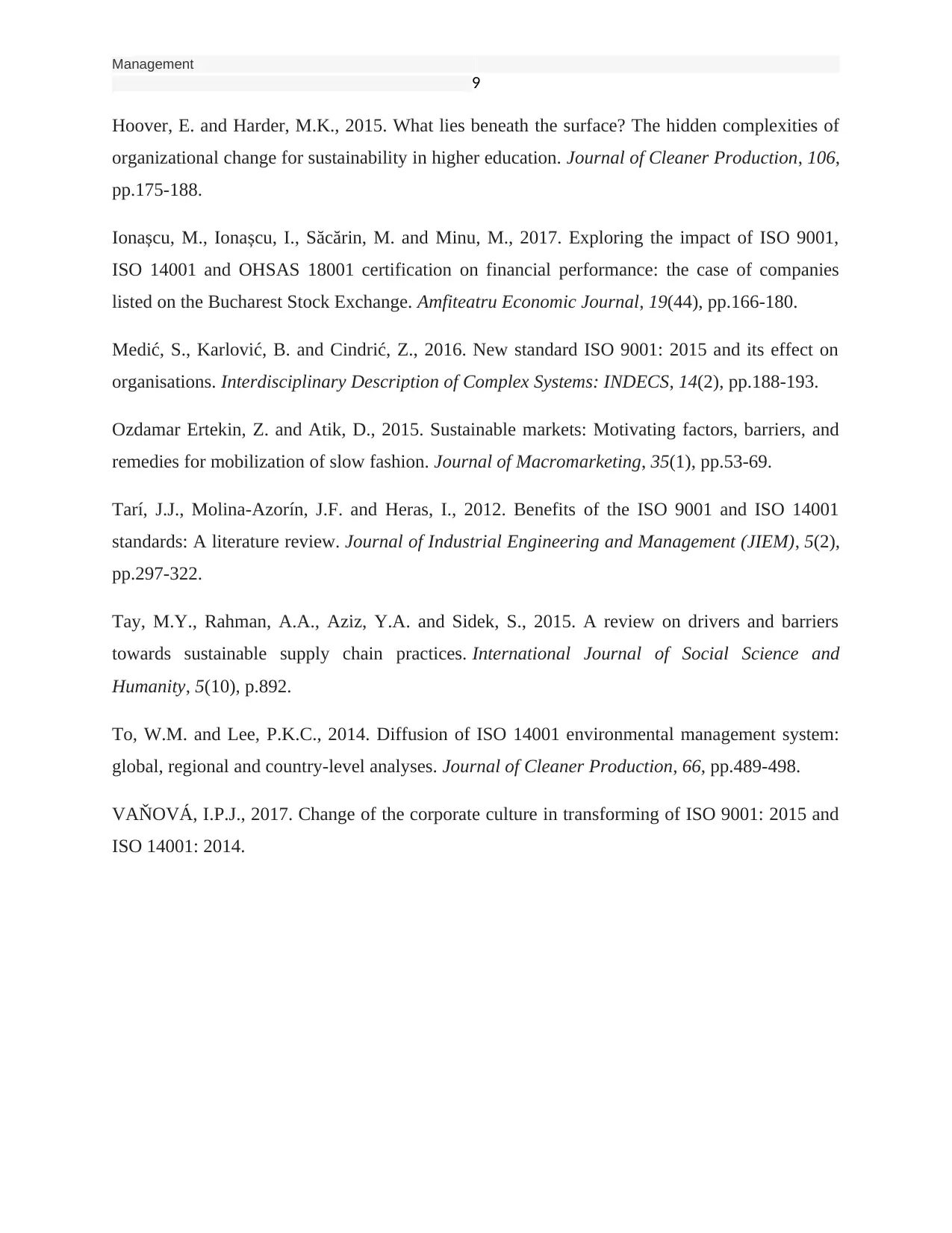
Management
9
Hoover, E. and Harder, M.K., 2015. What lies beneath the surface? The hidden complexities of
organizational change for sustainability in higher education. Journal of Cleaner Production, 106,
pp.175-188.
Ionașcu, M., Ionașcu, I., Săcărin, M. and Minu, M., 2017. Exploring the impact of ISO 9001,
ISO 14001 and OHSAS 18001 certification on financial performance: the case of companies
listed on the Bucharest Stock Exchange. Amfiteatru Economic Journal, 19(44), pp.166-180.
Medić, S., Karlović, B. and Cindrić, Z., 2016. New standard ISO 9001: 2015 and its effect on
organisations. Interdisciplinary Description of Complex Systems: INDECS, 14(2), pp.188-193.
Ozdamar Ertekin, Z. and Atik, D., 2015. Sustainable markets: Motivating factors, barriers, and
remedies for mobilization of slow fashion. Journal of Macromarketing, 35(1), pp.53-69.
Tarí, J.J., Molina-Azorín, J.F. and Heras, I., 2012. Benefits of the ISO 9001 and ISO 14001
standards: A literature review. Journal of Industrial Engineering and Management (JIEM), 5(2),
pp.297-322.
Tay, M.Y., Rahman, A.A., Aziz, Y.A. and Sidek, S., 2015. A review on drivers and barriers
towards sustainable supply chain practices. International Journal of Social Science and
Humanity, 5(10), p.892.
To, W.M. and Lee, P.K.C., 2014. Diffusion of ISO 14001 environmental management system:
global, regional and country-level analyses. Journal of Cleaner Production, 66, pp.489-498.
VAŇOVÁ, I.P.J., 2017. Change of the corporate culture in transforming of ISO 9001: 2015 and
ISO 14001: 2014.
9
Hoover, E. and Harder, M.K., 2015. What lies beneath the surface? The hidden complexities of
organizational change for sustainability in higher education. Journal of Cleaner Production, 106,
pp.175-188.
Ionașcu, M., Ionașcu, I., Săcărin, M. and Minu, M., 2017. Exploring the impact of ISO 9001,
ISO 14001 and OHSAS 18001 certification on financial performance: the case of companies
listed on the Bucharest Stock Exchange. Amfiteatru Economic Journal, 19(44), pp.166-180.
Medić, S., Karlović, B. and Cindrić, Z., 2016. New standard ISO 9001: 2015 and its effect on
organisations. Interdisciplinary Description of Complex Systems: INDECS, 14(2), pp.188-193.
Ozdamar Ertekin, Z. and Atik, D., 2015. Sustainable markets: Motivating factors, barriers, and
remedies for mobilization of slow fashion. Journal of Macromarketing, 35(1), pp.53-69.
Tarí, J.J., Molina-Azorín, J.F. and Heras, I., 2012. Benefits of the ISO 9001 and ISO 14001
standards: A literature review. Journal of Industrial Engineering and Management (JIEM), 5(2),
pp.297-322.
Tay, M.Y., Rahman, A.A., Aziz, Y.A. and Sidek, S., 2015. A review on drivers and barriers
towards sustainable supply chain practices. International Journal of Social Science and
Humanity, 5(10), p.892.
To, W.M. and Lee, P.K.C., 2014. Diffusion of ISO 14001 environmental management system:
global, regional and country-level analyses. Journal of Cleaner Production, 66, pp.489-498.
VAŇOVÁ, I.P.J., 2017. Change of the corporate culture in transforming of ISO 9001: 2015 and
ISO 14001: 2014.
1 out of 10
Related Documents
Your All-in-One AI-Powered Toolkit for Academic Success.
+13062052269
info@desklib.com
Available 24*7 on WhatsApp / Email
![[object Object]](/_next/static/media/star-bottom.7253800d.svg)
Unlock your academic potential
Copyright © 2020–2025 A2Z Services. All Rights Reserved. Developed and managed by ZUCOL.




